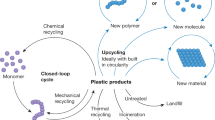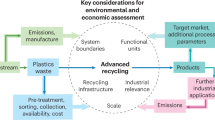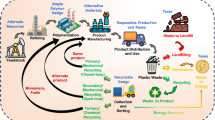Abstract
A diversity of chemicals are intentionally added to plastics to enhance their properties and aid in manufacture. Yet the accumulated chemical composition of these materials is essentially unknown even to those within the supply chain, let alone to consumers or recyclers. Recent legislated and voluntary commitments to increase recycled content in plastic products highlight the practical challenges wrought by these chemical mixtures, amid growing public concern about the impacts of plastic-associated chemicals on environmental and human health. In this Perspective, we offer guidance for plastics manufacturers to collaborate across sectors and critically assess their use of added chemicals. The ultimate goal is to use fewer and better additives to promote a circular plastics economy with minimal risk to humans and the environment.
This is a preview of subscription content, access via your institution
Access options
Access Nature and 54 other Nature Portfolio journals
Get Nature+, our best-value online-access subscription
$29.99 / 30 days
cancel any time
Subscribe to this journal
Receive 12 digital issues and online access to articles
$119.00 per year
only $9.92 per issue
Buy this article
- Purchase on SpringerLink
- Instant access to full article PDF
Prices may be subject to local taxes which are calculated during checkout


Similar content being viewed by others
References
Aurisano, N., Weber, R. & Fantke, P. Enabling a circular economy for chemicals in plastics. Curr. Opin. Green. Sustain. Chem. 31, 100513 (2021).
Wiesinger, H., Wang, Z. & Hellweg, S. Deep dive into plastic monomers, additives, and processing aids. Environ. Sci. Technol. 55, 9339–9351 (2021).
Carney Almroth, B., Dey, T., Karlsson, T. & Wang, M. Chemical simplification and tracking in plastics. Science 382, 525 (2023).
Zimmermann, L. et al. Plastic products leach chemicals that induce in vitro toxicity under realistic use conditions. Environ. Sci. Technol. 55, 11814–11823 (2021).
Dey, T. et al. Global plastic treaty should address chemicals. Science 378, 841–842 (2022).
Landrigan, P. J. et al. The Minderoo-Monaco Commission on Plastics and Human Health. Ann. Glob. Health 89, 23 (2023).
Maddela, N. R., Kakarla, D., Venkateswarlu, K. & Megharaj, M. Additives of plastics: entry into the environment and potential risks to human and ecological health. J. Environ. Manag. 348, 119364 (2023).
Ragaert, K. et al. Clarifying European terminology in plastics recycling. Curr. Opin. Green. Sustain. Chem. 44, 100871 (2023).
Brouwer, M. T., Alvarado Chacon, F. & Thoden Van Velzen, E. U. Effect of recycled content and rPET quality on the properties of PET bottles, part III: modelling of repetitive recycling. Packag. Technol. Sci. 33, 373–383 (2020).
Gerassimidou, S. et al. Unpacking the complexity of the PET drink bottles value chain: a chemicals perspective. J. Hazard. Mater. 430, 128410 (2022).
Geueke, B., Phelps, D. W., Parkinson, L. V. & Muncke, J. Hazardous chemicals in recycled and reusable plastic food packaging. Camb. Prisms Plast. 1, 1–43 (2023).
Global Plastics Outlook: Policy Scenarios to 2060 (OECD, 2022).
Kuczenski, B. & Geyer, R. PET bottle reverse logistics — environmental performance of California’s CRV program. Int. J. Life Cycle Assess. 18, 456–471 (2013).
Register, K. Littered Bottles and Cans: Higher in Virginia Than in States with Bottle Bills (Clean Virginia Waterways, Longwood University, 2020).
Marturano, V., Cerruti, P. & Ambrogi, V. Polymer additives. Phys. Sci. Rev. https://doi.org/10.1515/9783110468281-005 (2017).
Zweifel, H., Maier, R. D. & Schiller, M. Plastics Additives Handbook 6th edn (Hanser, 2009).
Strong, A. B. Plastics: Materials and Processing (Pearson Prentice Hall, 2006).
Li, H. et al. Expanding plastics recycling technologies: chemical aspects, technology status and challenges. Green Chem. 24, 8899–9002 (2022).
Westlie, A. H. et al. Polyolefin innovations toward circularity and sustainable alternatives. Macromol. Rapid Commun. 43, 2200492 (2022).
Schyns, Z. O. G. & Shaver, M. P. Mechanical recycling of packaging plastics: a review. Macromol. Rapid Commun. 42, 2000415 (2021).
Liu, X., Gao, C., Sangwan, P., Yu, L. & Tong, Z. Accelerating the degradation of polyolefins through additives and blending. J. Appl. Polym. Sci. 131, app.40750 (2014).
Selke, S. et al. Evaluation of biodegradation-promoting additives for plastics. Environ. Sci. Technol. 49, 3769–3777 (2015).
Napper, I. E. & Thompson, R. C. Environmental deterioration of biodegradable, oxo-biodegradable, compostable, and conventional plastic carrier bags in the sea, soil, and open-air over a 3-year period. Environ. Sci. Technol. 53, 4775–4783 (2019).
Teuten, E. L. et al. Transport and release of chemicals from plastics to the environment and to wildlife. Phil. Trans. R. Soc. Lond. B 364, 2027–2045 (2009).
Ziccardi, L. M., Edgington, A., Hentz, K., Kulacki, K. J. & Kane Driscoll, S. Microplastics as vectors for bioaccumulation of hydrophobic organic chemicals in the marine environment: a state-of-the-science review. Environ. Toxicol. Chem. 35, 1667–1676 (2016).
Bridson, J. H., Gaugler, E. C., Smith, D. A., Northcott, G. L. & Gaw, S. Leaching and extraction of additives from plastic pollution to inform environmental risk: a multidisciplinary review of analytical approaches. J. Hazard. Mater. 414, 125571 (2021).
Muncke, J. et al. Scientific challenges in the risk assessment of food contact materials. Environ. Health Perspect. 125, 095001 (2017).
Hinton, Z. R. et al. Antioxidant-induced transformations of a metal-acid hydrocracking catalyst in the deconstruction of polyethylene waste. Green Chem. 24, 7332–7339 (2022).
Lithner, D., Larsson, Å. & Dave, G. Environmental and health hazard ranking and assessment of plastic polymers based on chemical composition. Sci. Total. Environ. 409, 3309–3324 (2011).
Groh, K. J. et al. Overview of known plastic packaging-associated chemicals and their hazards. Sci. Total. Environ. 651, 3253–3268 (2019).
Wang, Z. & Praetorius, A. Integrating a chemicals perspective into the global plastic treaty. Environ. Sci. Technol. Lett. 9, 1000–1006 (2022).
Kahn, L. G., Philippat, C., Nakayama, S. F., Slama, R. & Trasande, L. Endocrine-disrupting chemicals: implications for human health. Lancet Diabetes Endocrinol. 8, 703–718 (2020).
Barrick, A. et al. Plastic additives: challenges in ecotox hazard assessment. PeerJ 9, e11300 (2021).
Geueke, B. et al. Systematic evidence on migrating and extractable food contact chemicals: most chemicals detected in food contact materials are not listed for use. Crit. Rev. Food Sci. Nutr. 63, 9425–9435 (2022).
Lynch, J. M., Knauer, K. & Shaw, K. R. in Plastics and the Ocean (ed. Andrady, A. L.) 43–76 (Wiley, 2022).
Hahladakis, J. N., Velis, C. A., Weber, R., Iacovidou, E. & Purnell, P. An overview of chemical additives present in plastics: migration, release, fate and environmental impact during their use, disposal and recycling. J. Hazard. Mater. 344, 179–199 (2018).
Hermabessiere, L. et al. Occurrence and effects of plastic additives on marine environments and organisms: a review. Chemosphere 182, 781–793 (2017).
Rummel, C. D. et al. Effects of leachates from UV-weathered microplastic in cell-based bioassays. Environ. Sci. Technol. 53, 9214–9223 (2019).
Gunaalan, K., Fabbri, E. & Capolupo, M. The hidden threat of plastic leachates: a critical review on their impacts on aquatic organisms. Water Res. 184, 116170 (2020).
Amaneesh, C. et al. Gross negligence: impacts of microplastics and plastic leachates on phytoplankton community and ecosystem dynamics. Environ. Sci. Technol. 57, 5–24 (2023).
Karapanagioti, H. K. & Werner, D. in Hazardous Chemicals Associated with Plastics in the Marine Environment. Handbook of Environmental Chemistry Vol. 78 (eds Takada, H. & Karapanagioti, H. K.) 205–220 (Springer, 2019).
Tian, Z. et al. A ubiquitous tire rubber-derived chemical induces acute mortality in coho salmon. Science 371, 185–189 (2021).
Turner, A., Wallerstein, C., Arnold, R. & Webb, D. Marine pollution from pyroplastics. Sci. Total. Environ. 694, 133610 (2019).
Zimmermann, L., Dierkes, G., Ternes, T. A., Völker, C. & Wagner, M. Benchmarking the in vitro toxicity and chemical composition of plastic consumer products. Environ. Sci. Technol. 53, 11467–11477 (2019).
Escher, B. I., Stapleton, H. M. & Schymanski, E. L. Tracking complex mixtures of chemicals in our changing environment. Science 367, 388–392 (2020).
Scholz, S. et al. The eco‐exposome concept: supporting an integrated assessment of mixtures of environmental chemicals. Environ. Toxicol. Chem. 41, 30–45 (2022).
Caporale, N. et al. From cohorts to molecules: adverse impacts of endocrine disrupting mixtures. Science 375, eabe8244 (2022).
Martin, O. et al. Ten years of research on synergisms and antagonisms in chemical mixtures: a systematic review and quantitative reappraisal of mixture studies. Environ. Int. 146, 106206 (2021).
Silva, E., Rajapakse, N. & Kortenkamp, A. Something from ‘nothing’ — eight weak estrogenic chemicals combined at concentrations below NOECs produce significant mixture effects. Environ. Sci. Technol. 36, 1751–1756 (2002).
Signoret, C., Caro-Bretelle, A.-S., Lopez-Cuesta, J.-M., Ienny, P. & Perrin, D. Alterations of plastics spectra in MIR and the potential impacts on identification towards recycling. Resour. Conserv. Recycl. 161, 104980 (2020).
Roosen, M. et al. Operational framework to quantify ‘quality of recycling’ across different material types. Environ. Sci. Technol. 57, 13669–13680 (2023).
Gall, M., Freudenthaler, P. J., Fischer, J. & Lang, R. W. Characterization of composition and structure–property relationships of commercial post-consumer polyethylene and polypropylene recyclates. Polymers 13, 1574 (2021).
Rung, C. et al. Identification and evaluation of (non-)intentionally added substances in post-consumer recyclates and their toxicological classification. Recycling 8, 24 (2023).
Ahamed, A. et al. Technical and environmental assessment of end-of-life scenarios for plastic packaging with electronic tags. Resour. Conserv. Recycl. 201, 107341 (2024).
Bhubalan, K. et al. Leveraging blockchain concepts as watermarkers of plastics for sustainable waste management in progressing circular economy. Environ. Res. 213, 113631 (2022).
Coates, G. W. & Getzler, Y. D. Y. L. Chemical recycling to monomer for an ideal, circular polymer economy. Nat. Rev. Mater. 5, 501–516 (2020).
Uekert, T. et al. Technical, economic, and environmental comparison of closed-loop recycling technologies for common plastics. ACS Sustain. Chem. Eng. 11, 965–978 (2023).
Kusenberg, M. et al. Opportunities and challenges for the application of post-consumer plastic waste pyrolysis oils as steam cracker feedstocks: to decontaminate or not to decontaminate? Waste Manag. 138, 83–115 (2022).
Jerdy, A. C. et al. Impact of the presence of common polymer additives in thermal and catalytic polyethylene decomposition. Appl. Catal. B 325, 122348 (2023).
Scallon, C. UK circular economy explained. Biffa https://www.biffa.co.uk/biffa-insights/circular-economy-explainer---biffa-insights (2023).
Anastas, P. T & Warner, J. C. Green Chemistry: Theory and Practice (Oxford Univ. Press, 1998).
Zimmerman, J. B., Anastas, P. T., Erythropel, H. C. & Leitner, W. Designing for a green chemistry future. Science 367, 397–400 (2020).
Lubongo, C. & Alexandridis, P. Assessment of performance and challenges in use of commercial automated sorting technology for plastic waste. Recycling 7, 11 (2022).
Bǎlan, S. A. et al. Optimizing chemicals management in the United States and Canada through the essential-use approach. Environ. Sci. Technol. 57, 1568–1575 (2023).
Tsochatzis, E. D., Lopes, J. A. & Corredig, M. Chemical testing of mechanically recycled polyethylene terephthalate for food packaging in the European Union. Resour. Conserv. Recycl. 179, 106096 (2022).
Schyns, Z. O. G., Patel, A. D. & Shaver, M. P. Understanding poly(ethylene terephthalate) degradation using gas-mediated simulated recycling. Resour. Conserv. Recycl. 198, 107170 (2023).
Demets, R. et al. Addressing the complex challenge of understanding and quantifying substitutability for recycled plastics. Resour. Conserv. Recycl. 174, 105826 (2021).
Ferg, E. E. & Bolo, L. L. A correlation between the variable melt flow index and the molecular mass distribution of virgin and recycled polypropylene used in the manufacturing of battery cases. Polym. Test. 32, 1452–1459 (2013).
A Chemicals Perspective on Designing with Sustainable Plastics: Goals, Considerations and Trade-Offs (OECD, 2021).
Zimmermann, L. et al. Implementing the EU chemicals strategy for sustainability: the case of food contact chemicals of concern. J. Hazard. Mater. 437, 129167 (2022).
Cousins, I. T. et al. Finding essentiality feasible: common questions and misinterpretations concerning the ‘essential-use’ concept. Environ. Sci. Process. Impacts 23, 1079–1087 (2021).
Fenner, K. & Scheringer, M. The need for chemical simplification as a logical consequence of ever-increasing chemical pollution. Environ. Sci. Technol. 55, 14470–14472 (2021).
Melnikov, F., Kostal, J., Voutchkova-Kostal, A., Zimmerman, J. B. & Anastas, P. T. Assessment of predictive models for estimating the acute aquatic toxicity of organic chemicals. Green Chem. 18, 4432–4445 (2016).
Lizarraga, L. E. et al. Advancing the science of a read-across framework for evaluation of data-poor chemicals incorporating systematic and new approach methods. Regul. Toxicol. Pharmacol. 137, 105293 (2023).
Mayr, A., Klambauer, G., Unterthiner, T. & Hochreiter, S. DeepTox: toxicity prediction using deep learning. Front. Environ. Sci. https://doi.org/10.3389/fenvs.2015.00080 (2016).
Klambauer, G., Clevert, D.-A., Shah, I., Benfenati, E. & Tetko, I. V. Introduction to the special issue: AI meets toxicology. Chem. Res. Toxicol. 36, 1163–1167 (2023).
Ward, C. P., Reddy, C. M., Edwards, B. & Perri, S. T. To curb plastic pollution, industry and academia must unite. Nature 625, 658–662 (2024).
Law, K. L. & Narayan, R. Reducing environmental plastic pollution by designing polymer materials for managed end-of-life. Nat. Rev. Mater. 7, 104–116 (2022).
James, B. D., Ward, C. P., Hahn, M. E., Thorpe, S. J. & Reddy, C. M. Minimizing the environmental impacts of plastic pollution through eco-design of products with low environmental persistence. ACS Sustain. Chem. Eng. 12, 1185–1194 (2024).
Chemicals in Plastics (UNEP, 2023).
Fantke, P., Aurisano, N., Provoost, J., Karamertzanis, P. G. & Hauschild, M. Toward effective use of REACH data for science and policy. Environ. Int. 135, 105336 (2020).
Customisation Opportunities of IUCLID for the Management of Chemical Data 3rd edn. OECD Series on Testing and Assessment No. 297 (OECD, 2023).
Krebs, A. et al. The EU-ToxRisk method documentation, data processing and chemical testing pipeline for the regulatory use of new approach methods. Arch. Toxicol. 94, 2435–2461 (2020).
Richard, A. M. et al. ToxCast chemical landscape: paving the road to 21st century toxicology. Chem. Res. Toxicol. 29, 1225–1251 (2016).
Williams, A. J. et al. The CompTox chemistry dashboard: a community data resource for environmental chemistry. J. Cheminformatics 9, 61 (2017).
Olker, J. H. et al. The ECOTOXicology Knowledgebase: a curated database of ecologically relevant toxicity tests to support environmental research and risk assessment. Environ. Toxicol. Chem. 41, 1520–1539 (2022).
Winder, C., Azzi, R. & Wagner, D. The development of the Globally Harmonized System (GHS) of classification and labelling of hazardous chemicals. J. Hazard. Mater. 125, 29–44 (2005).
Globally Harmonized System for the Classification and Labeling of Chemicals 10th revised edn (UNECE, 2023).
Groh, K. J., Geueke, B., Martin, O., Maffini, M. & Muncke, J. Overview of intentionally used food contact chemicals and their hazards. Environ. Int. 150, 106225 (2021).
Scheringer, M., Johansson, J. H., Salter, M. E., Sha, B. & Cousins, I. T. Stories of global chemical pollution: will we ever understand environmental persistence? Environ. Sci. Technol. 56, 17498–17501 (2022).
Cousins, I. T., Ng, C. A., Wang, Z. & Scheringer, M. Why is high persistence alone a major cause of concern? Environ. Sci. Process. Impacts 21, 781–792 (2019).
Yazid, M. F. H. A., Ta, G. C. & Mokhtar, M. Classified chemicals in accordance with the globally harmonized system of classification and labeling of chemicals: comparison of lists of the European Union, Japan, Malaysia and New Zealand. Saf. Health Work 11, 152–158 (2020).
A Framework to Guide Selection of Chemical Alternatives (National Research Council, 2014).
Acknowledgements
The authors thank S. Trenor and K. Kortsen for feedback on earlier drafts of the manuscript. K.L.L. was supported by March Marine Initiative (a programme of March Limited, Bermuda). M.J.S. acknowledges support from the Donahue Center for Business Ethics and Social Responsibility at the University of Massachusetts Lowell and funding from NSF CAS-MNP grant no. 2304991. M.P.S. thanks the Industrial Strategy Challenge Fund in Smart Sustainable Plastic Packaging (grant NE/V01045X/1). M.E.H. was supported by March Marine Initiative and by the Woods Hole Center for Oceans and Human Health (funding from NIH/NIEHS grant P01ES028938 and NSF grant OCE-1840381).
Author information
Authors and Affiliations
Contributions
All authors contributed to the design and content of the manuscript, including drafting, creating display items, editing and revision.
Corresponding author
Ethics declarations
Competing interests
The authors declare no competing interests.
Peer review
Peer review information
Nature Reviews Materials thanks Kathryn Beers, Zhanyun Wang and the other, anonymous, reviewer(s) for their contribution to the peer review of this work.
Additional information
Publisher’s note Springer Nature remains neutral with regard to jurisdictional claims in published maps and institutional affiliations.
Related links
Design for Recycling Guidance: https://recyclass.eu/news/apr-and-recyclass-work-to-align-design-for-recycling-guidance/
Directive 2019/904 of the European Parliament: https://eur-lex.europa.eu/eli/dir/2019/904/oj
Ellen MacArthur Foundation Global Commitment: https://www.ellenmacarthurfoundation.org/global-commitment-2022/overview
Open 3P: https://www.open3p.org/
Plastic Additive Standards Guide: https://www.accustandard.com/media/assets/Plastic_Add_Guide2018.pdf
Plastics Pact Network: https://www.ellenmacarthurfoundation.org/the-plastics-pact-network
Position Statement on Biobased and Biodegradable Plastic: https://files.worldwildlife.org/wwfcmsprod/files/Publication/file/5tm1hfp3vz_WWF_Position_Biobased_and_Biodegradable_Plastic.pdf
Position Statement on Degradable Additives: https://plasticsrecycling.org/images/position_statements/APR-Position-Degradable-Additives.pdf
RecyClass Testing Methods: https://recyclass.eu/recyclability/test-methods/
Statement on Oxo-Degradable Plastic Packaging: https://emf.thirdlight.com/link/kfivzcx91l81-86a71k/@/preview/1
Rights and permissions
Springer Nature or its licensor (e.g. a society or other partner) holds exclusive rights to this article under a publishing agreement with the author(s) or other rightsholder(s); author self-archiving of the accepted manuscript version of this article is solely governed by the terms of such publishing agreement and applicable law.
About this article
Cite this article
Law, K.L., Sobkowicz, M.J., Shaver, M.P. et al. Untangling the chemical complexity of plastics to improve life cycle outcomes. Nat Rev Mater 9, 657–667 (2024). https://doi.org/10.1038/s41578-024-00705-x
Accepted:
Published:
Issue Date:
DOI: https://doi.org/10.1038/s41578-024-00705-x
This article is cited by
-
Recyclable plastics from a manganese catalyst
Nature Chemistry (2025)
-
A Comprehensive Overview of Chemical Additives in Single-Use Polimeric Products: Functionality, Environmental Impact and the Analytical Greenness Assessment
Water, Air, & Soil Pollution (2025)
-
Environmental consequences of interacting effects of changes in stratospheric ozone, ultraviolet radiation, and climate: UNEP Environmental Effects Assessment Panel, Update 2024
Photochemical & Photobiological Sciences (2025)
-
Defining quality by quantifying degradation in the mechanical recycling of polyethylene
Nature Communications (2024)



